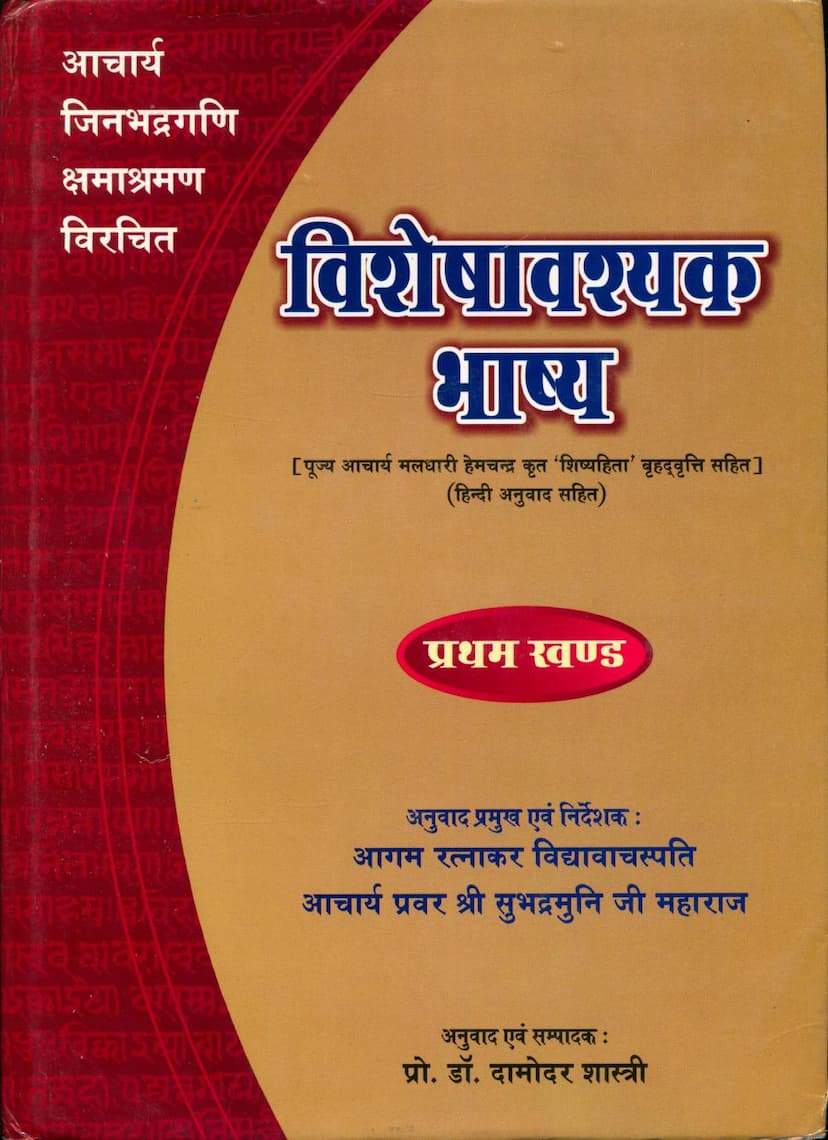Visheshavashyak Bhashya Part 01
Added to library: September 2, 2025

Summary
Here's a comprehensive summary of the provided Jain text, "Visheshavashyak Bhashya Part 01," based on the provided pages:
Book Title: Visheshavashyak Bhashya Part 01 Author(s): Subhadramuni, Damodar Shastri (Translation and Editing) Original Author: Acharya Jinbhadragani Kshamaashraman Commentary: Brihat Vritti 'Shishyadhita' by Acharya Maladhari Hemachandra Publisher: Muni Mayaram Samadhi Prakashan
Overview and Significance:
This volume presents the first part of the Hindi translation of the highly revered Jain text, the Visheshavashyak Bhashya. The original work, authored by Acharya Jinbhadragani Kshamaashraman approximately 1500 years ago, is a detailed commentary on the Avashyak Sutra, specifically its first study, the Samayik Sutra. The Visheshavashyak Bhashya itself is a profound commentary on the Avashyak Niyukti by Acharya Bhadrabahu (II), which in turn explains the Avashyak Sutra.
The Avashyak Sutra holds a fundamental place in Jainism, outlining the essential daily practices and disciplines (Sadhanas) for both monks (Sramanas) and lay followers (Shravakas). These practices, known as the Sadaavashyak (six essentials), include Samayik, Chaturvinshtistav, Vandan, Pratikraman, Kayotsarg, and Pratyakhyan. These are considered crucial for self-purification, introspection, and spiritual progress. The text emphasizes that the disruption of even one evening's Avashyak ritual can lead a seeker astray from the path of spiritual practice.
The Visheshavashyak Bhashya by Acharya Jinbhadragani is considered a monumental work, offering detailed philosophical and doctrinal explanations. Later, Acharya Maladhari Hemachandra wrote a vast commentary on it, the Shishyadhita (approximately 28,000 verses).
The Translator and His Vision:
The present Hindi translation is attributed to the spiritual leadership and direction of Pujya Acharya Shri Subhadramuni Ji Maharaj, who is recognized as a significant authority on Jain Agamas in the 21st century. His profound wisdom, rooted in his virtuous conduct and practice, is evident in the translation. The text highlights his dedication to making the vast treasury of Jain Agamas accessible to Hindi-speaking audiences, bridging the gap for those who do not know Prakrit and Sanskrit. Amit Rai Jain, General Secretary of S.S. Jain Sabha, Baraut, notes that Pujya Acharya Shri Subhadramuni Ji Maharaj is the first monk to undertake a comprehensive translation of the Visheshavashyak Bhashya into Hindi, a task that opens new avenues of knowledge for scholars and seekers.
Structure and Content (Indicative from Table of Contents):
The volume covers a vast range of topics, providing an encyclopedic overview of Jain philosophy, ethics, and practices. Key areas explored include:
- Introduction and Mangal Nirupan: Discussion on auspicious beginnings, the importance of prayer and reverence, and the philosophical underpinnings of auspicious rituals.
- Anuyoga and its Principles: Explaining various aspects of Jain scripture categorization and application.
- Discipline and Conduct of Monks: Detailing the rigorous practices of monks, including aspects of the Sthavirkalp and Jinkalp.
- Namasakar Anu yoga: An in-depth analysis of the significance and manifold interpretations of the Jain Namasakar Mantra.
- Knowledge (Jnana): Detailed exploration of the five types of Jain knowledge (Mati, Shruta, Avadhi, Manahparyaya, Kevala), including their origins, characteristics, and distinctions. This section delves into the nature of perception, direct versus indirect knowledge, the role of senses, and the workings of the mind.
- Agama Literature: A significant portion of the text is dedicated to tracing the origins and development of Jain Agama literature, including the Angas, Upangas, Mul Sutras, and Ched Sutras. It discusses the role of various Acharyas like Bhadrabahu, Jinbhadragani, and Hemachandra.
- The 'Avashyak' Sutra: A detailed exposition of the Avashyak Sutra, its six components, its paramount importance in Jain practice, and its philosophical significance.
- Methodology of Interpretation: The text outlines the methodologies used in Jain scriptural interpretation, such as Niyukti, Bhashya, Churni, and Tika, and highlights the importance of Anuyoga and its various stages (Upakram, Nikshetra, Anugam, Naya).
- Philosophical Debates and Schools: The text touches upon various philosophical concepts, comparative religion, and refutes opposing doctrines from other philosophical schools, demonstrating the logical rigor of Jain philosophy.
- In-depth discussion on specific concepts: The table of contents reveals detailed discussions on the nature of 'Naya' (standpoints), 'Nikshetra' (categories), 'Moola-Naya', the examination of 'Moola-Naya', the classification of 'Dravya-Mangala' (material auspiciousness) and 'Bhava-Mangala' (spiritual auspiciousness), the intricate classification of 'Mati' and 'Shruta' knowledge, and the subtle distinctions within these.
- Historical and Cultural Context: The work provides insights into the historical, cultural, and philosophical milieu in which Jain literature flourished, referencing the contributions of various esteemed Acharyas and the evolution of scriptural texts.
The Contribution of the Translators:
The translation and editing by Professor Dr. Damodar Shastri, a distinguished scholar of Jainism and comparative religions, along with the guidance of Acharya Shri Subhadramuni Ji Maharaj, ensures accuracy and accessibility. Their combined efforts make this profound text available to a wider audience, facilitating a deeper understanding of Jain teachings. The publication is a significant endeavor in making rare and ancient Jain manuscripts accessible in the national language.
Overall, the Visheshavashyak Bhashya Part 01 (Hindi Translation) is presented as an invaluable scholarly and spiritual resource, offering a comprehensive and systematic exploration of fundamental Jain principles and practices, and serving as a testament to the rich intellectual and spiritual heritage of Jainism.